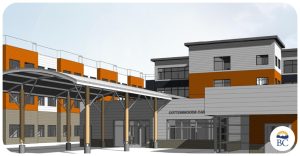Typically, the average government contract leaves nothing to chance, spelling out just how, when and where the job must be completed.
More recently, however, a government agency took a less prescriptive approach to a tricky demolition project at a Montreal airport, which is also used by the Canadian Armed Forces.
Time was of the essence. The 4,000-square-metre M4 hangar dated back to the ’40s and the roof had become unstable and needed to come down before the next winter hit. It was so unstable that just getting in and out of the space was a risk.
Instead of hiring a consultant then developing a detailed plan and asking for bids, Defence Construction Canada (DCC) sketched out the rough specifications around hazardous materials and other challenges then asked bidders to offer their best strategies for dealing with the job and disposing of the materials.
The location was the old RCAF Station St. Hubert that was decommissioned in 1997 but still operates under the Canadian Armed Forces administration as a base for 438 Tactical Helicopter Squadron. It was built in 1942 as a training school and for decades was a key asset to Canada’s fighter squadrons.
The structure was a Warren truss warehouse with timber columns and temporary steel supports carrying the roof said Vincent Bousquet, DCC site manager.
"There were four of these buildings there at St. Hubert, now there are two left. There were many of these built across Canada during the war and they were supposed to be temporary," he said.
"It was used primarily as a depot for storage and some mechanical work on vehicles."
The problem was stability and while it lasted the winter of 2013-14, things had to get moving quickly to get the structure down, or at least the roof, before the snow flew in 2014-15.
"Normally we’d hire a consultant and then an engineer and then write a prescriptive proposal but that would have taken too much time," Bousquet said. "It was spring when we started and we really needed to get moving before the fall."
The solution was to use something DCC calls an innovative performance specification, which essentially translates to stating the intended results from the get-go and giving the contractor relative freedom in choosing the means and methods to do the work. It’s not something government agencies use that often because it increases the risk compared with conventional contract structures.
DCC had come up with the concept earlier in an environmental contaminant clean-up project. While that contract was prescriptive and conventional, there was a lot of back and forth between the contract and the DCC project team and in the end they realized they should have just let the expert handle it.
With that in mind, because of the nature of the job, DCC realized it could work more efficiently and faster opting for this approach, rather than going the traditional route.
"We were a little delayed so work didn’t start until the fall," said Bousquet. "We were worried about how they were going to get in there to get the roof, but they just went at it with their machines from the top down."
It was all done and safe within the timelines and once the roof was down, it was a disposal job. The price was also attractive: $300,000.
One of the attractions for winning bidder A&A Demolition was that the timbers were in good shape and had strong salvage value which led to a competitive bid.








Recent Comments
comments for this post are closed